Related Research Articles
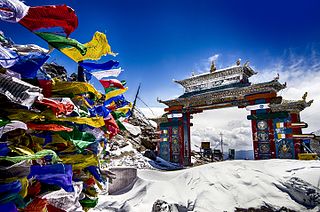
Northeast India, officially the North Eastern Region (NER), is the easternmost region of India representing both a geographic and political administrative division of the country. It comprises eight states—Arunachal Pradesh, Assam, Manipur, Meghalaya, Mizoram, Nagaland and Tripura, and the "brother" state of Sikkim.

The Insurgency in Northeast India involves multiple separatist militant groups operating in some of India's northeastern states, which are connected to the rest of India by the Siliguri Corridor, a strip of land as narrow as 14.29 miles (23.00 km) wide.
The Hmar language belongs to the Mizo language branch of the Sino-Tibetan family of languages. The speakers of this language use Mizo language as their second language (L2).
The Paite people are an ethnic group in Northeast India, mainly living in Manipur and Mizoram. The Paites are recognized as a scheduled tribe in these two states. They are part of the Kuki-Zo people, but prefer to use the Zomi identity. "Guite" is a major clan of the Paite people.
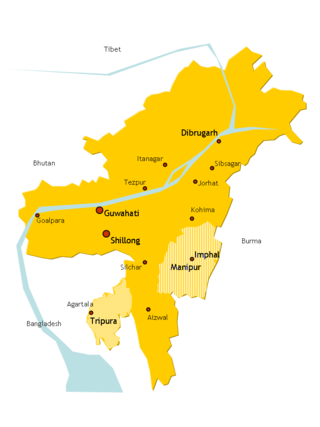
The history of Mizoram encompasses the history of Mizoram which lies in the southernmost part of northeast India. It is a conglomerate history of several ethnic groups of Chin people who migrated from Chin State of Burma. But information of their patterns of westward migration are based on oral history and archaeological inferences, hence nothing definite can be said. The recorded history started relatively recently around the mid-19th century when the adjoining regions were occupied by the British monarchy. Following religious, political and cultural revolutions in the mid-20th century majority of the people agglomerated into a super tribe, Mizo. Hence the officially recognised settlement of the Mizos became Mizoram.
The Hmar Students' Association (HSA), established in Imphal, Manipur, India, is a large student organisation among the indigenous Hmar people.
Tipaimukh Sub-Division is located in south-western hilly region of Manipur bordering the Indian state of Mizoram. It is one of the six tribal development blocks of Churachandpur district in Manipur state. Parbung is the sub-divisional block headquarters. The total geographic area of the sub-division block is 789.48 km², having 55 villages with the total population of 23,995 approx. The total number of voters is 18,848. The total distance from the Parbung to the district headquarters town of Churachandpur is 247 km through the Tipaimukh Road, also known as NH 150.
Rochunga Pudaite was an Indian minister of Hmar descent. He translated the Bible into the Hmar language and founded Bibles for the World. He was a renowned speaker and an evangelist. His organisation, Bibles for the World, has allowed distribution of the Christian Bible to millions of people around the world, by mailing Bibles in different languages to them.
Zo is a Northern Kuki-Chin-Mizo language originating in western Burma and spoken also in Mizoram and Manipur in northeastern India.
Churachandpur, locally known as Lamka, is the second largest town in the Indian state of Manipur and the district headquarters of the Churachandpur District. The name "Churachandpur" was transferred from the earlier headquarters of the district at Songpi to the present location, and honours Churachand Singh, former maharaja of the Manipur princely state. The local Kuki-Zo people reject the name as a colonial imposition and use the native name "Lamka".
The Zo people is a term to denote the ethnolinguistically related speakers of the Kuki-Chin languages who primarily inhabit northeastern India, western Myanmar, and southeastern Bangladesh.

The Biates are an ethnic hill tribe of Assam, Meghalaya, Mizoram, Tripura and Manipur. Their language belongs to the Tibeto-Burman family. Spread over many parts of North-East India, they have a unique identity with a rich and distinctive history, culture, dialect and religious heritages. They are one of the oldest hill tribes of North East India especially among the Chin-Kuki-Mizo people. The term Biate comes from the word Bia-te. The word ‘Bia’ or ‘Biak’ means ‘speak’ or ‘worship’. ‘Te’ is a suffix denoting plurality. Hence, the two words combine to form the word Biate, which means worshipper.
Edwin Rowlands was a Welsh Christian missionary in northeast India and Burma. He was a professional teacher, singer, composer, poet, translator and literary figure among the Mizo people. He was regarded as the most beloved of all British missionaries in Mizoram. He was more popularly known as Zosapthara. He made the major hymns in Mizo and Khumi which are still in use. He modified the original Mizo alphabet and his system became the standard in Mizo language. He created written language for Khumi people in Burma, and for Bhil people in Maharashtra. His literary works are the foundation of Mizo literature. He was the first administrator of education in Mizoram as Honorary Inspector of Schools. Despite objection from various corners he married Thangkungi, a Mizo girl.
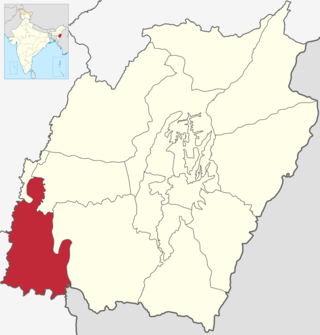
Pherzawl district is located in the southern part of the state of Manipur. It is bounded on the east by Churachandpur District; on the north by Tamenglong District, Noney District and Jiribam district; on the west by the Cachar District of Assam and on the South by Sinlung Hills, Mizoram. Pherzawl District has approximately 200 villages.
Lal Dena is a historian of modern South Asia with special interest in Manipur and Mizoram. He is a retired professor of Manipur University and the former Vice Chancellor of Sangai International University, Churachandpur. He is from the Hmar tribe.
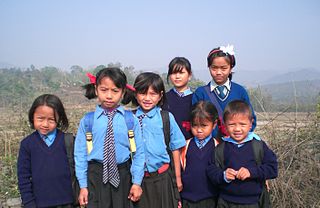
The hill tribes of Northeast India are hill people, mostly classified as Scheduled Tribes (STs), who live in the Northeast India region. This region has the largest proportion of scheduled tribes in the country.
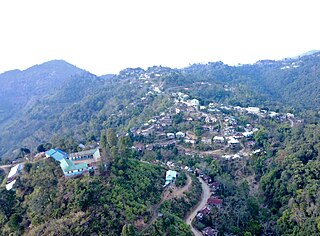
Parbung is a Hmar village in Pherzawl District, Manipur and is the headquarters of the Parbung Sub-Division. Prior to 2017, it used to be the headquarters of the larger Tipaimukh Sub-Division, It is also the center of a district council constituency of the Churachandpur Autonomous District Council.

Senvawn is a Hmar village in Pherzawl district, Northeast India and is attributed to be the 'birthplace' of Christianity in Southern Manipur. The initial Christian converts among the Hmar and other sister tribes was made by a Welsh missionary Watkin Roberts in 1910. Senvon is also the 8th District Council Constituency (DCC) in the Churachandpur Autonomous District Council. According to the 2011 census, Senvawn holds 498 households
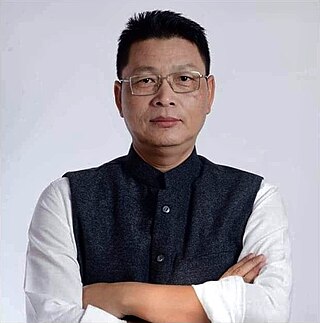
Ngursanglur Sanate is an Indian politician. He is a member of the Manipur Legislative Assembly from Tipaimukh Assembly constituency and hails from the Bharatiya Janata Party. He is the son of Indian politician Ngurdinglien Sanate who served as a cabinet minister and a deputy speaker of the Manipur Legislative Assembly and had won four times as an MLA from the same constituency. Ngursanglur is from the Hmar tribe.
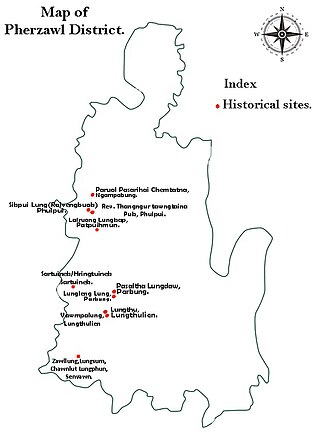
The Hmar Ethnic Cultural Sites are a series of ethno-cultural sites of the Hmar people. These sites are located within Pherzawl district, Manipur, India.
References
- ↑ Census of India 2011 (2011). "Hmar" Language - India, State and Union Territories (PDF). Office of the Registrar General, India. p. 9.
{{cite book}}: CS1 maint: numeric names: authors list (link) - ↑ https://tribal.nic.in/ST/LatestListofScheduledtribes.pdf
- ↑ https://tribal.nic.in/WriteReadData/CMS/Documents/201212010344115039062File1061.pdf
- ↑ https://data.gov.in/resource/population-mother-tongue-2011-manipur
- ↑ "Scheduled Tribes" (PDF). DISTRICT CENSUS HANDBOOK CHURACHANDPUR (PDF). Directorate of Census Operations Manipur. 2011. p. 28.
- ↑ https://data.gov.in/resource/population-mother-tongue-2011-mizoram
- ↑ https://data.gov.in/resource/population-mother-tongue-2011-assam
- ↑ https://data.gov.in/resource/population-mother-tongue-2011-meghalaya
- 1 2 3 Census of India 2011 (2011). "Hmar" - Language: India, States and Union Territories (Table C-16) (PDF). Office of the Registrar General, India. p. 9.
{{cite book}}: CS1 maint: numeric names: authors list (link) - ↑ "MIZORAM DATA HIGHLIGHTS : THE SCHEDULED TRIBES Census of India 2001" (PDF). censusindia.gov.in. Retrieved 6 April 2020.
- ↑ https://joshuaproject.net/people_groups/16937/IN
- ↑ Dena, Lal (2008). In Search of Identity: Hmars of North East India. Akansha Publishing House: Delhi.
- ↑ "About". Bibles For The World. Retrieved 13 May 2024.
